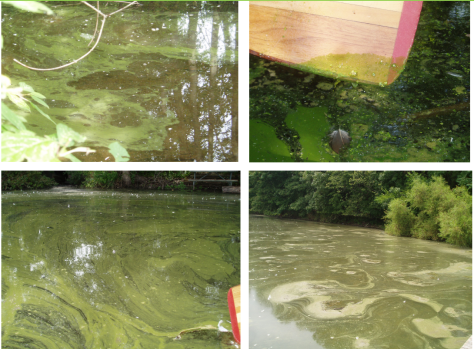There has been a lot of activity in New York State this spring regarding Harmful Algal Blooms (HABs)! In an effort to raise awareness regarding HABS, Governor Cuomo called together four HAB Summit Meetings across the State (February 27 in New Paltz, March 6 at SUNY ESF, March 20 in Ticonderoga, and March 26 in Rochester). Leading experts from the Department of Health (DOH), Department of Environmental Conservation (DEC), Department of Agriculture and Markets (DAM) and other state and national experts convened to discuss and address the causes of algal blooms in 12 priority waterbodies across the state. The meetings were the first step in the development of action plans to address HAB occurrences in each waterbody. Of the 12 priority waterbodies chosen as part of the Governor’s initiative to combat HABs, five of them are the home of State Park’s beaches, marinas, or campgrounds (Conesus Lake, Honeoye Lake, Chautauqua Lake, Cayuga Lake and Lake Champlain). The action plans will be used to implement monitoring and treatment projects related to HABS.
What’s the problem with HABs?
You might see a couple of different terms used in association with HABs, but they mean the same thing: cyanobacteria and blue green algae are used interchangeably. The term “blue-green algae” is a misnomer; it is not truly algae. It is a type of bacteria called cyanobacteria that is capable of photosynthesis. An algal “bloom” consists of cyanobacteria in great enough numbers of cells to be seen by the naked eye. Some algal blooms can produce toxins, but not all do. When an algal bloom produces toxins, it is called a Harmful Algal Bloom. HABs can thrive when certain conditions are met, including warm weather, stagnant water, and sufficient nutrients in the water body. The bacteria can form dense mats on the surface of a lake or can be suspended in the water column. The blooms can be brightly colored and look like pea soup, spilled paint, or an oily scum/sheen that coats the lake surface. The blooms move around the lake in response to wind and currents, tend to accumulate at shorelines, and can move vertically in the water column to find the perfect nutrient and temperature conditions to flourish. Blooms occur most often in waters high in phosphorous and/or nitrogen, and research is ramping up to determine the exact causes of algal blooms.
Because of the potential for blooms to produce toxins, it is important to keep people and pets out of the water during a bloom. The toxins can make people and animals sick, and toxin exposure can cause a range of symptoms, including rashes, respiratory irritation, gastrointestinal troubles, and effects on the liver. HABs may also impact drinking water and recreational activities, and can cause unpleasant odors.
It is State Parks Policy to follow the DOH protocol and close bathing beaches when a HAB is present. To re-open a beach at a State Park, the beach must be free of any signs of a bloom for 24 hours, and a water sample must be submitted for toxin analysis.
The Big Message for the 2018 Beach Season
Know it, Avoid it, Report it. Learn what a bloom looks like, avoid it, and make sure to report it to the Park Manager if you see a potential bloom at a State Park. You can also notify the NYS Department of Environmental Conservation, or harmfulalgae@health.ny.gov
HAB Photos from State Parks:

Below are a few links to learn more about HABs!
NYS Department of Health: Harmful Blue-Green Algae Blooms
Environmental Protection Agency: Cyanobacterial Harmful Algal Blooms in Water
NYS Department of Environmental Conservation: Harmful Algal Blooms


Can you send weekly updates on algae blooms?
Hi-
The NYS Dept of Conservation maintains a list of HAB outbreaks across the state. Follow this link to the most recent report: http://www.dec.ny.gov/chemical/83310.html